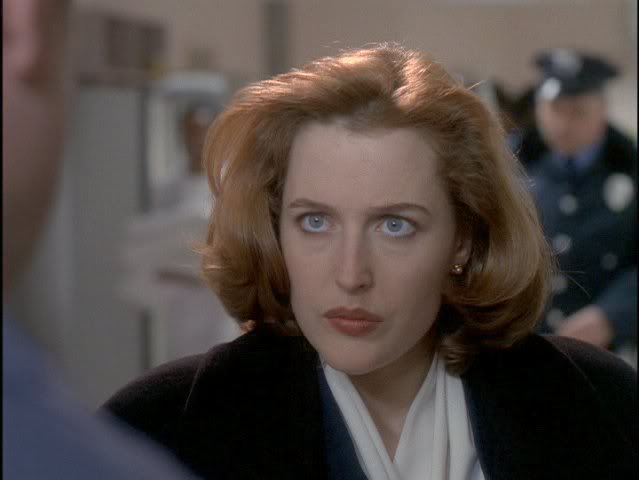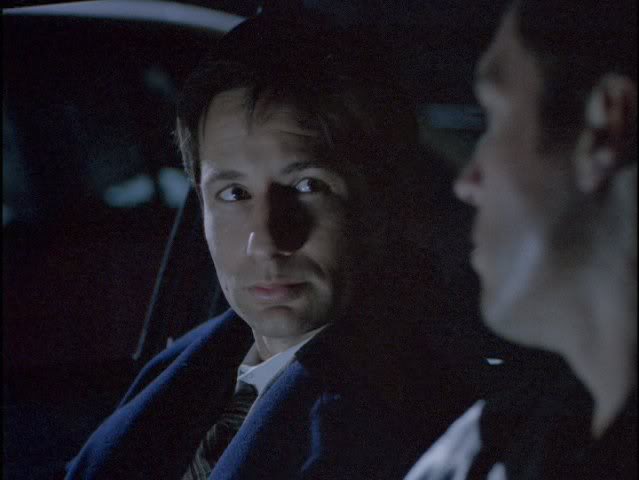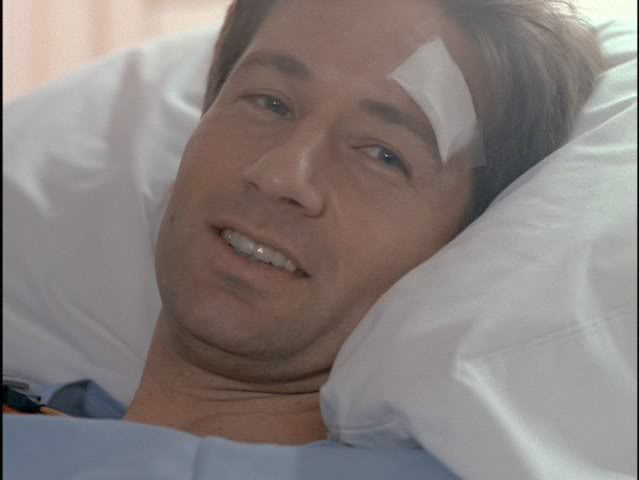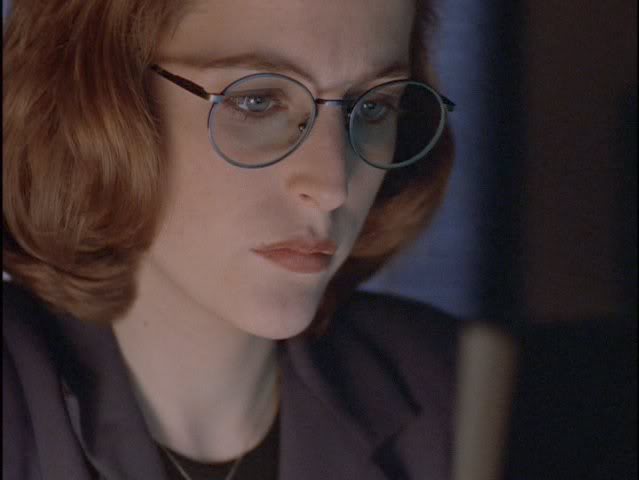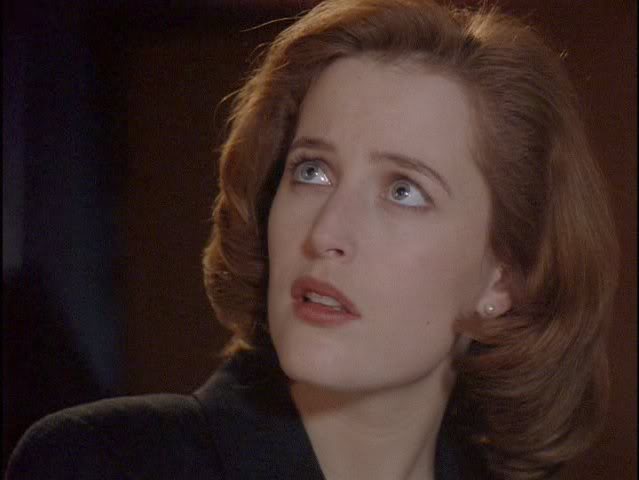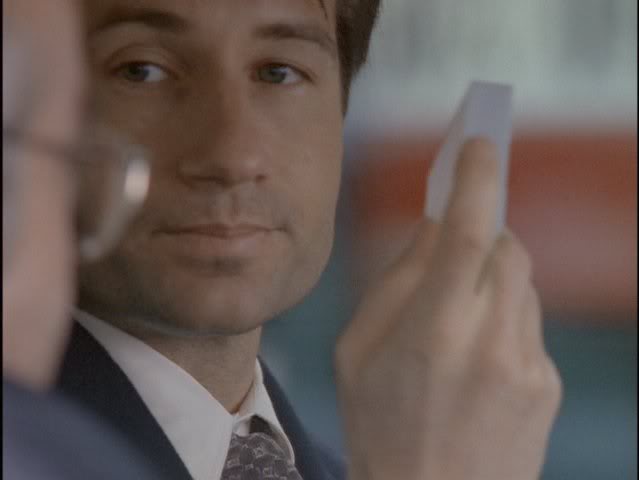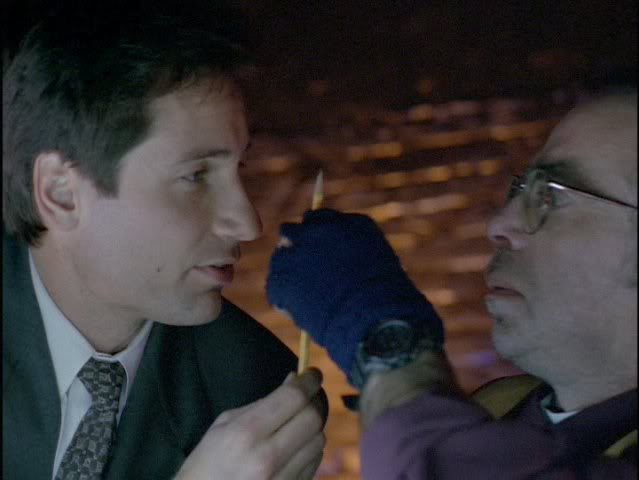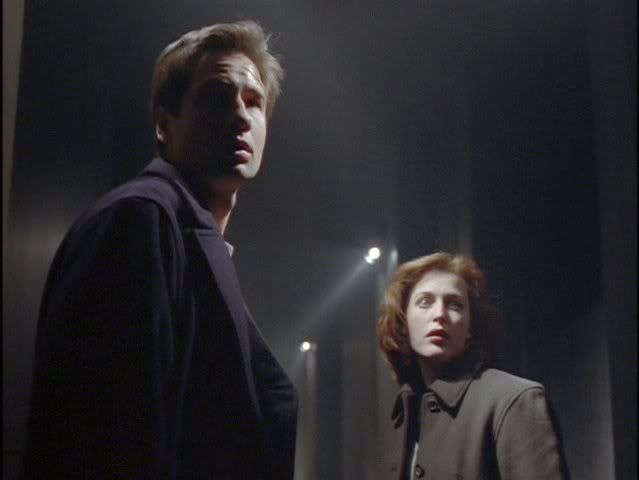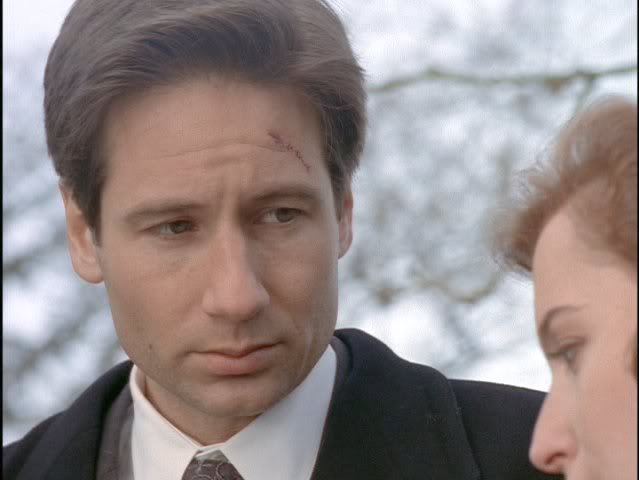REPOST - CTP Episode of the Day - 05.02.06 – Apocrypha
Today's Cherished Episode: Apocrypha (3x16)
Original Air Date: February 16, 1996
Written By: Frank Spotnitz and Chris Carter
Directed By: Kim MannersMulder pursues Krycek and the mystery of the sunken World War II wreckage, while the shooting of Skinner brings Scully new clues to her sister's murder.
"I think the dead are speaking to us, Mulder, demanding justice. Maybe that man was right. Maybe we bury the dead alive."
-- Apocrypha is from the Greek apokryptein, "to hide away," and in its broadest sense, has come to mean any writings of dubious authority or authenticity. The history of the term's usage indicates that it referred to a body of esoteric writings that were at first prized, later tolerated, and finally excluded. In Biblical literature, it describes works excluded from the accepted Jewish and Protestant canon of scripture.
-- "'Apocrypha' is really the original documents that became the Bible," explained series creator Chris Carter. "There is a lot of information in tablets, text, and things that didn't make it into the Bible; they are sort of pre-Biblical. The story we were telling was about documents, and about information that had not been brought to light yet, so I think the significance of the word was important to the show."
-- After handling a variety of stand-alone episodes ranging from horror to comedy, this was Kim Manners' first directing assignment on a mythology episode and his first opportunity to contribute to the larger lore of the series -- and he loved it. He welcomed the change as he felt the mythology episodes were more character driven. "Before this one, I always seemed to get the monster of the week," said Manners.
-- "I was rather nervous about directing my first mythology show, as it was a big learning experience for me," recalled Manners. "I'd done a lot of standalone episodes, four, five, six, seven ... but this was the first time I was picking up the story midstream and responsible for not only telling a story correctly, but knowing that it was open-ended, that it was going to go further, and it was a big learning experience for me because I understood the nuances of the mythology for the first time."
-- The black and white flashback sequence in the teaser was directed by Rob Bowman for the first half of the two-parter, "Piper Maru."
-- "We hadn't had a chance to flashback in time much before this two-parter," said Carter, "and the use of black-and-white was very effective in telling the story particularly with the black oil."
-- "The black oil was a Mat Beck effect," Carter said, "which was very difficult because he had to put a digital black oil on a curved surface for the eyes and make it seem believable and I think that was a real challenge for him. I think they shot that a number of times before they actually got it right. And then getting the consistency of this oil right was also difficult. Originally we had wanted it to travel in such a fashion that it looked like it had sentience but Mat, and I think everyone else, decided in the end that it was better to just let it run down the drain."
-- Because Mat Beck was having difficulty digitally creating the eye effect, the look was generated by introducing an oily substance into water, with Beck then taking that footage and digitally inserting it into shots of the actors' faces. "No one had to wear contacts," David Gauthier explained. "We shot it four different times," Beck added. "When you can get the shot practically [as opposed to digitally], you always try to."
-- "We had a lot to do in 'Apocrypha,'" said Mat Beck. "The first time the scene in the teaser was shot, it was shot with some magnetic fluid that's being pulled along with a magnet and it didn't look real convincing and it didn't look real menacing. In fact it looked a little bit comic and this was not a show where comedy was called for. So we actually built a platform that had the floor of the submarine and we mounted the camera and the lights and everything else to it. Then we put the goop on and we rocked the entire floor every which way to make the goop flow where we wanted it to, but it doesn't look like the floor was rocking because the lights and the camera were all mounted to it."
-- Makeup effects artist Toby Lindala noted that the effect when the black ooze dripped out of the submarine captain's head represented a major technical accomplishment -- utilizing a full dummy head of the actor that contained six different hoses feeding into each facial orifice. "The quality of work from our shop had really evolved," he said, citing an increase in puppetry as well as remote-control articulation as the show progressed.
-- The "Piper Maru/Apocrypha" two-parter was "where the mythology really began to take advantage of historical events and written history," said Chris Carter. "I think it began to some extent at the end of season two, then through season three, where we started playing with not just the Axis powers but with sort of more specific and finer pieces of history, including parts of World War II and with Scully's father's involvement in that, and ultimately with Mr. Mulder's involvement in World War II."
-- "The end of the teaser was another example of taking history and using X-Files characters, in this case Mulder's father and the Cigarette Smoking Man, and placing them in history at certain times and bringing the mythology forward with those characters," Carter said. "I remember trying to cast the actor to play young Peter Donat, and this guy coming in and looking exactly like what we thought he would look like as a young man, I think actually even like his pictures, so that was fortunate, but I still wondered if the audience would be able to make the leap between a young Mr. Mulder, who they'd seen actually not many times, particularly because he had died some episodes previously, if they would actually make the connection. But I think with the Cigarette Smoking Man and the lighting of the cigarette, the audience made an immediate connection to who it was they were seeing, about 30 some odd years previously."
-- Continuity Oopsie: In the teaser young Bill Mulder and the Cigarette Smoking Man were shown to already be involved in the conspiracy and the year was 1953. However, in "Musings of a Cigarette-Smoking Man," Bill Mulder and CSM were shown to be in the Army in 1963.
-- "I remember looking at the location list for this episode and for 'Piper Maru,' and thinking how ambitious we had all tried to be with giving this a movie scope and the number of locations," recalled Carter. "I think it was more than ambitious, it was probably a little foolish to try to do so much but Bob Goodwin by this point had become a kind of catcher. We would pitch up our scripts to him and he would catch them and figure out a way to get them done and this was one of those that was hugely, not just ambitious, but costly and difficult to get finished because it took place in so many different places, had so many actors, had such big scope and production value. Not only was Bob up to the test, but I think Kim, because this was his first mythology episode, wanted to give it his all and didn't know what he was getting himself into."
-- "For instance, that was an actual emergency room," noted Manners about the scenes featuring Skinner and Mulder in the hospital, which were filmed at Mount St. Joseph's Hospital, located at 3080 Prince Edward Street. "And we only had so many hours to shoot in there. As I recall, my stomach was turning to try to get the work done because they said if anybody came in, if there was actually a gunshot victim or something, they'd shut us down. So I was quite nervous shooting that sequence. Fortunately it was a quiet night in Vancouver and we got our sequence shot."
-- "Luckily there aren't many gunshot wounds in Vancouver," Carter joked.
-- The scene where Mulder and Krycek picked up their rental car at Dulles Airport was filmed on the back lot of the North Shore Studios in Vancouver, behind the construction mill located there.
-- Carter noted that the same location was used as a rental car business in a number of different episodes, shot from several different angles. "Lariat had more business on the X-Files than any other rental agency," Carter said. "Mulder and Scully were very loyal to Lariat."
-- "I think you could really date the show back through Gillian Anderson's hairstyles," said Carter in the DVD commentary for this episode. "They were so different over the years and when you look at her years later, actually I think in a way her hairstyle came back around to kind of what it was in this episode except for a little curl, undercurl there. But length and everything else through season 8, it was actually surprising to see how little she changed."
-- Kim Manners recalled it was a "freezing cold" night when he filmed the scene where Mulder and Krycek's car was run off the road. "We were out on an insert car," Manners said. "It was very difficult to light the scene because we had to drive so many blocks and we didn't want to see that car behind us, but we did see it, which was very difficult."
-- "That's something that was often asked of X-Files directors," said Carter, "to see something but not see it. In the course of a show like ours, this was just one little sequence, yet it was very, very difficult to pull off physically and logistically. Particularly with big stunts, like the car hitting the barrels, and then a huge light effect. The producers were writing these stories and maybe being a little bit naive about what was actually accomplishable in a television schedule. But people like Kim and Bob Goodwin and the entire Vancouver crew -- instead of saying 'no,' they always said 'we'll find a way.'"
-- The big lighting effect following the car crash "took forever to light," Manners said. "We shot the scene all in one night and we literally never stopped running. As a matter of fact, I don't think we ever broke for dinner that night. I think everybody just walked with a meal in their hands in order to get the work done."
-- The car crash scene was filmed under the Highway 17 overpass in Delta.
-- "Agent Pendrell was not introduced in this episode, but it was the first time Scully spent any time with him," said Carter. "Pendrell would become a sort of beloved character on the show who met an untimely end. That drew a lot of criticism from the fans, when we offed him, because he was Scully's little bit lovelorn associate and he had a sort of comedic quality that he added to the show. The character provided information for us -- that was the purpose of the character, to be a familiar face to come back to and to keep the story moving."
-- This was Brendan Beiser's third appearance as Agent Pendrell. He appeared in 10 episodes in all.
-- Kim Manners recalled that the burned man visited by the Cigarette Smoking Man was actually a stuntman named Ernie - though he couldn't remember Ernie's last name. "He was quite a sport," said Manners. "He was in that makeup for hours."
-- The Cigarette Smoking Man lighting up in the hospital-like setting was "perfectly indicative of his character's cold-heartedness," said Carter. "As if that wasn't cold-hearted enough, his final line in that scene was 'kill these men, they're going to die anyway.' It was interesting to see the Cigarette Smoking Man and the role he had taken by this time in Season 3, when he had only just spoken for the first time about a year previously, some 22 or 23 episodes previously. Here he was all of a sudden taking on a huge amount of weight of the arc and mythology of the show. That was fortunate for us, because he was like the devil; he became very important to the underlying evil of the conspiracy and a person we'd go back to again and again."
-- "We prepped these shows in eight days and in Vancouver, we shot them in eight days with the main unit, and then we'd go three, four, or five more days with the second unit," said Manners. "The Vancouver shows had a lot more production than we were able to accomplish in the shows in Los Angeles. We did a lot of very big things in Vancouver. In this episode, we did a huge CGI shot, a huge crane lashup, and some other really big things."
-- "I really believe that there will never ever be another show like the X-Files on television in terms of its production value and ambition," Carter said, "because first of all, I think it's just going to be too expensive. I think that by being in Vancouver we were able to do a lot of things budgetarily that shows can't do in Los Angeles. There was a crew up there that was game for anything and it really was a coincidence of those events, financial and personnel coming together, that really gave us the scope and storytelling ability to create this wonderful mythology. I just can't imagine that anyone would be able to get the funds or the freedom that we were given by Fox, by Charlie Goldstein who was the head of production at Fox, and be able to do some of the things we did and pull off some of the amazing work."
-- At Mulder's bedside in the hospital, Scully showed him PCR results. Polymerase chain reaction (PCR) is a technique which is used to amplify the number of copies of a specific region of DNA, in order to produce enough DNA to be adequately tested. This technique can be used to identify with very high-probability, disease-causing viruses and/or bacteria, a deceased person, or a criminal suspect.
-- "You would think that Mulder's face would be a lot more scarred up with all the beatings he took over the years," joked Carter, "with all the little nicks and scratches and cuts, near-misses."
-- "Since this was my first mythology show, it was obviously my first Syndicate scene," recalled Manners. "I borrowed from Rob Bowman in hiding the Syndicate fathers back in the shadows, as shadowy figures, with a lot of smoke in the room and a lot of backlight. I must credit Rob for a scene like that because he was the one, I think, that set the style in the Syndicate office. So I borrowed from that, not only in this episode but subsequent episodes. We always shot the Syndicate office kind of in the same style, the guys in the background, a lot of smoke, and I think Rob set that pace."
-- "We used so many hospitals in The X-Files and Vancouver just happened to be one of those cities that had, it seemed like, always had a vacant hospital or a hospital that would let us come in," said Carter. "We were, I think, allowed into working hospitals on an amazing frequent basis and it was really important to the success of the show because so much of it revolved around victims and/or trauma, even involving Mulder and Scully as it did in this episode. So we never, to my knowledge, created hospital sets on stage. There may have been a time where we created a hospital room, but we always had a good supply of hospitals waiting."
-- "The character of Skinner always had to walk the line between his loyalty to Mulder and Scully and to the X-Files, and also to the FBI," said Manners, "and this was a situation where his loyalty earned him a near-fatal gunshot wound. Skinner's character proved very important to these mythology episodes just because of that role he played, because his loyalties were mixed and strained, and he was always the go-to guy when it came to Mulder and Scully going out on the lam against the wishes of the FBI and Skinner being able to cover for them, reining them in, or suffering the consequences."
-- In his DVD commentary, Kim Manners noted that Scully's glasses "look so dated to me now, but they were so good for a director when we did shots like the one where Scully was typing on the computer because we could always pick up the reflection in those big lenses really well. As the series went on, she didn't have glasses like that any more."
-- 517 references: The case number for this episode was #621517; and the number on the key and locker where the digital tape's box was found was 517. (5/17 is the birth date of Frank Spotnitz's wife.)
-- "The diving suit was a real thing to figure out," recalled Manners. "That thing, they brought it into Mulder's office and it was so big I had no idea where to put the camera. So I had to hoist it clear up into the air and shoot down on Mulder and the suit just to get a tie-up. I was flabbergasted when I saw the size of that suit."
-- The diving suit was an Atmospheric Diving Suit or ADS, a small one-man articulated submersible of anthropomorphic form which resembles a suit of armor, with elaborate pressure joints to allow articulation while maintaining an internal pressure of one atmosphere. The ADS can be used for very deep dives of up to 2300 feet for many hours, and eliminates the majority of physiological dangers associated with deep diving; the occupant need not decompress, there is no need for special gas mixtures, and there is no danger of decompression sickness or nitrogen narcosis. Divers do not even need to be skilled swimmers.
-- The ADS used in the episode was a "Newt Suit," developed by Canadian engineer Phil Nuytten in 1987. The Newt Suit is constructed to function like a "submarine you can wear." Made of cast aluminum, it had fully-articulated joints so the diver could move more easily underwater. The life support system provided six to eight hours of air, with an emergency back-up supply of an additional 48 hours.
-- "That particular suit was actually manufactured just about a block away from The X-Files," said Chris Carter. "Dave Gauthier, our physical effects man, came to me and told me about this suit, and when I heard that they had it and that it was available to us, we figured out a way to use it. So this was a case where we had a resource and used it to develop a story. That suit was a one-atmosphere suit, which means no matter what depth you go to, you are still at basically the same atmosphere that you are at on the surface. We shot some of it in the previous episode in a tank about a block away from the X-Files as well, so we made use, as we often did, of just about everything that we possibly could in and around Vancouver."
-- Mulder told Scully that figuring out what the black oil was looking for was "the $64,000 question." The $64,000 Question was a popular U.S. television game show from 1955 to 1958. To play the game, contestants first chose a subject category. The contestant would then be asked questions only in the chosen category, earning money which doubled after each question, with the first question worth $1 and the final question worth $64,000. The contestant could quit at any time and retire with their money, or if they got the question wrong, they were eliminated. Almost immediately, the show was a gigantic hit, earning the #1 rating spot for the 1955-56 season, holding the distinction of being the only television show to knock I Love Lucy out of first place in the ratings. The show's big winners became instant celebrities; and one, Joyce Brothers (who answered questions about boxing), went on to dispense psychological advice in newspaper columns and on television for the next four decades. But three years after it exploded into the nation's consciousness, The $64,000 Question and its many imitators were dead -- victims of the Charles Van Doren quiz show scandal on the program Twenty-One.
-- The Lone Gunmen ice skating scene was filmed at the outdoor skating rink located in a lower level at Robson Square, a modern civic center and public plaza located in downtown Vancouver. Robson Square is the site of the Provincial Law Courts, the University of British Columbia at Robson Square, government office buildings, and public space connecting the newer development to the Vancouver Art Gallery. The scene where the Lone Gunmen gave Mulder the evidence they found was filmed on Howe Street at Robson Street.
-- Chris Carter recalled the scene at Robson Square as the "famous ice-rink scene which the Lone Gunmen had to practice because as Americans we just considered it to be natural that all native Canadians knew how to ice skate."
-- The three actors portraying the Lone Gunmen did prove to be more than a little shaky on ice skates. "It was true, I'm afraid," said Dean Haglund (Langly). Haglund said he spent most of his childhood cross-country skiing but that he had never skated. The actor-comic subjected himself to a five-day crash course, taking the "crash" part a bit too literally.
-- Assistant director and part-time actor Tom Braidwood (Frohike) said it had been "a long, long time" since he had skated, so he bought skates and went out and practiced on weekends in anticipation of his big (albeit brief) scene. Though Braidwood said he enjoyed skating again, he admitted with a laugh that he was "terrified of falling," proudly adding, "I didn't fall once."
-- Bruce Harwood (Byers) looked comfortable during the ice skating scene because he once trained as a professional ice skater.
-- "We had to put the camera on a sled and literally push the camera around the ice with the actors," explained Manners. "It was quite a scene. And myself, I have never been on ice skates so I was in my tennis shoes slipping and falling down. All the Canadians were laughing at me."
-- "In the script, the character of Frohike was supposed to ogle a few more women while skating on the ice," Carter said, "but I think it was too tall an order to get Tom Braidwood to skate and ogle at the same time, so we saved that little moment for the scene at the lockers."
-- "Vancouver was great," Carter reminisced on his DVD commentary. "Kim knows as well as anyone; he spent so many days out in the elements. It was great because it gave you free atmosphere. No matter what the weather was like, it was always interesting, whether it was rain, cold, or moisture in the air, it gave it a kind of claustrophobic quality. You didn't know how much you'd miss it until you came to a place like Los Angeles where you got very little atmosphere and had to create it if you wanted it. I know that for me, directing in Los Angeles, we spent a lot more time smoking things up than we would ever do in Vancouver. I don't know if we created much rain after we got to L.A., but of course, that was something that Vancouver gave you gratis."
-- "We did so many productions in Vancouver," added Manners. "We would gather a crowd, especially if David or Gillian or Nick or Mitch was working; but other than that, they people in Vancouver kind of go about their business and you can actually photograph them going about their life in the background, very few gawkers really."
-- It seemed as if each time we got a glimpse of CSM at home, he was sitting alone, drinking, watching an old war movie, and someone was breaking into his house.
-- "The Syndicate scenes are interesting to me to look back at," said Carter in his DVD commentary, "because they really set up the ultimate Syndicate scene which was in Fight the Future. The movie didn't come out until after season five, but these types of scenes had to be considered and thought about when Frank Spotnitz and I were coming up with the story for the movie, which was not long after this episode was filmed. All the players were the same in the X-Files movie scene, including the Elder who was killed shortly thereafter in the mythology arc."
-- William Davis (Cigarette Smoking Man) hated smoking the clove cigarettes on the show so much that he actually had someone else light the cigarettes for him.
-- "After we came to Los Angeles at the beginning of the sixth season, Bill Davis insisted that we build a machine to light the cigarettes for him," said Kim Manners. "We had a little battery-operated machine that they'd plug the cigarettes in and it made a whining noise and that was Bill's cigarettes being lit for him by a machine. That way, no other human lips actually touched the cigarette."
-- Carter said that the Well Manicured Man "was such an important counterpoint to the Syndicate because he was an honest man with integrity. In fact, his character could always be counted on to tell Mulder and Scully the truth up to the point where he felt comfortable doing so, so he was really the direct opposite person to the Cigarette Smoking Man who was venal and could never be trusted. Ultimately the Well Manicured Man would divulge a tremendous amount of information. He was rather forthcoming to Mulder, and I thought he was really the necessary addition to the group so they didn't just seem underhanded and evil. He was really the conscience of the group and gave them some dimension."
-- "The scene between Mulder and the Lone Gunmen at their office was funny because it made use of character and of budget constraints," Carter explained. "We had the Lone Gunmen talking about a very sophisticated device that the FBI could use to find the piece of evidence while Mulder was just running a pencil over the top of it. So as we were poking fun at the characters and talking about crime-fighting technology, we had Mulder push the story forward by finding the evidence with simply a lead pencil."
-- Carter called actor Kevin McNulty (Agent Fuller) "one of the best character actors in Vancouver who appeared on The X-Files a number of times." Kim Manners said he directed McNulty in about a "hundred different episodes of television in Vancouver."
-- "For production reasons, we often had to split the characters of Mulder and Scully up just to get the work done," said Carter. "And the scene with Mulder meeting the Well Manicured Man in Central Park was exactly that sort of scene. We did that so that David could be off filming second unit somewhere or so Gillian could have some time off when David was working. It was really a trick just to create what we called a board, to get the work done using actors who were running back and forth, shuttling between several different units at once."
-- "Central Park" in the episode, where Mulder and the Well Manicured Man met, was actually Stanley Park, just outside downtown Vancouver. The scene was filmed near the Lord Stanley Statue, a prominent feature in the park. "There were a whole lot of directions I couldn't point the camera," said Manners. "Just behind us in the scene was the entire Vancouver skyline, which looked nothing like New York City, so it was rather tricky to shoot. It was a freezing cold night; you could see the actors' breath in the scene. We were in the middle of the third season, so it must have been about January or February that we were filming."
-- In his conversation with Mulder, the Well Manicured Man called the UFO a "foo fighter." Foo fighter was a term used in World War II to refer to the types of aerial sightings that, in the postwar period, became known as UFOs. They were usually assumed to be some sort of enemy secret weapon or experimental aircraft. Many were described as "blobs or flares of light." The 1953 Robertson Panel, a CIA committee convened in 1952 to examine the rash of UFO reports, reviewed the foo fighter sightings and noted that many objects sighted during the war were metallic and disc shaped and that if the term flying saucer had been in use then, it would have been appropriate. Due to the ephemeral nature of the sightings, it also became synonymous with "red herring." The term is thought to have been taken from the Smokey Stover comic strip, which ran in the Chicago Tribune from 1935 to 1973. Smokey, a fireman, drove a two-wheeled fire truck he called the Foomoble. One of his catchphrases was "Where there's foo, there's fire." The strip's artist, Bill Holman, never explained the term. By using this term, the Well Manicured Man alluded to UFOs, dismissed the matter as inconsequential, and dated himself as part of the World War II generation. In 1995, former Nirvana drummer (and X-Files fan) Dave Grohl named his new band Foo Fighters.
-- "This was the third set of mythology episodes we had done," said Carter. "We would end up doing I think seven mythology episodes of 24 episodes in Season 3, and this was really where we found our pace. For the seasons after this one, I think we would end up doing about that amount because it felt like the right balance."
-- "This was the resurfacing of the black oil which really got the ball rolling on the entire mythology, the entire alien being of the black oil," said Manners. "The introduction of the black oil and its body-jumping capabilities," added Carter. "That would form so much of the mythology, so much that it became the important part or the glue of the X-Files movie which was kind of the culmination of so much of the mythology. The Well Manicured Man would ultimately die, or we would assume he died, in the X-Files movie and he really did die for his sin of not being quite evil enough. I think that was evident in his scene with Mulder in this episode. He was forthcoming with Mulder, but just forthcoming enough that it sent Mulder off on a path which would save the life of Skinner as it put the life of Scully in jeopardy."
-- "As a director, I always felt that the things the Well Manicured Man gave Mulder he gave for a reason," said Manners, "and that he'd only give him just enough in trade, almost, if he ever needed to come back to Mulder to call in a favor, that he felt he could." Carter agreed with that assessment, adding, "He always felt to me like he believed in the conspiracy and the good of the conspiracy but he did not necessarily like the men that he had become involved with."
-- "The scene between Scully and Cardinal was the first scene I shot with Gillian Anderson where I knew that lady had tremendous talent," said Manners. "When she tackled that guy in the alley and got him down and started screaming about 'did you shoot my sister, did you kill my sister,' I saw a side of that lady's performance that absolutely blew my mind."
-- The scene where Scully chased down Cardinal was filmed at 355 Burrard Street, near Gastown. "We had control of the entire street, an alley right off of Robson," Manners said. "All the cars in the scene were ours, we had everything locked up."
-- "The character of Cardinal took a lot of abuse, but he dolled out a lot of abuse in the series," said Carter. "He was the man who was sitting in the car with Krycek in another episode, who left Krycek and went into a store, knowing full well that there was a bomb in the car that would have ended Krycek's life if he hadn't figured it out. He had a long arc in the show and was a kind of all-purpose assassin. The actor's name was Lenno Britos. The scene were Scully confronted him was a big scene for Scully emotionally because she knew the man she was looking at was the man who killed her sister and that was what took us through the act-break -- that emotion."
-- "I attended a wedding where the judge who was marrying the couple was an X-Files fan," Carter recalled in his DVD commentary. "Knowing who I was, she came up to me and said, 'I was just in this building here and I couldn't get cell phone reception. How is it that Mulder and Scully can get cell phone reception when they're two miles underground?' That was true. I don't think we could have done a show like The X-Files without cell phones, so it was timely that we did it in the 90s when cell phone technology was familiar to everyone. But she was right, Mulder and Scully always seemed to get perfect reception -- of course, until the times when we didn't want them to."
-- The scene at the missile silos which were supposed to be located in Black Crow, North Dakota, was filmed in Boundary Bay, which is on the border of British Columbia in Canada and the state of Washington in the U.S.
-- "We scouted that location before there was snow on the ground," said Carter. "We didn't know there would be snow on the ground by the time we were ready to shoot the scene, which was supposed to be happening in North Dakota. So we got this gift of a few inches of snow. Once again, free production value. I can't tell you how many times that happened on The X-Files, where we'd shoot Florida and get seven days of sunshine, like Kim got on an episode like 'Humbug.' We would get perfect Florida skies even though it would be almost freezing, but Mother Nature just cooperated way too many times for it to be just a coincidence."
-- "The scene where the car drove up to the missile site took forever to shoot," explained Manners, "because the wind was blowing and it was a lock-off of a crane, and the grips worked for hours trying to get it locked off. They thought they'd succeeded and the wind would come up and move the crane a little bit, and it had to be perfectly still so that we could do the artwork of all the missile silos there in the background."
-- The "artwork" that Manners spoke of was created by visual effects wizard Mat Beck. "This was supposed to be a missile launch facility," Beck said, "so we just computer generated some missile launch, like the tops of silos, and we stuck them around the landscape, so the car drove up and there were silos all over the place. And of course when Scully and Mulder went into a silo, we didn't have a silo, so we had a stage and you could see the roof of the stage and there was a little bit of a set piece with them. One of the things we asked the actors to do was please control the flashlights so that they didn't cross in front of the fake stage, and of course, they did, but that was all right. We fixed it anyway. So in the final thing, we made them a lot smaller. We made the silo look a lot bigger and we made it look like it went all the way round, which most silos would be expected to do."
-- "For that entire sequence the set was only two corridors with a small intersection," said Manners. "We were able to figure out enough camera angles to make the thing look like it went on, a labyrinth of hallways, and like it went on forever. The silo shot was a set that was about 18 feet high and we shot it at the top. I think we had a 9.8 mm lens, and then Mat Beck made that thing look like it was ten stories tall. All of the lights, that was all CGI. He did a magnificent job."
-- "I look at those shots and I know how much all of us as directors owed to Kim Manners, because he was able to make the most of a camera position," Carter said. "We'd watch the transfers and watch the way he moved actors and the way he blocked actors and I know all of us were always studying how he did it because Kim not only did it well, he was able to get so much work done in the little amount of time that we had. So I know we always went to school on his episodes."
-- "There were many shots in the silo sequence where you would never imagine that there were only two hallways," Carter continued. "That was Graeme Murray, our amazing production designer. When we were in the middle of shooting Season 8, I called him out of the blue because looking at old episodes, I was constantly reminded what kind of look he gave the show for so little money and so little time. That was not just him but his entire crew up in Vancouver, including Robbie Maier, his head of construction, who worked round the clock building those amazing sets for us."
-- The scene outside the silo between Mulder and Scully and the Cigarette Smoking Man was the first X-Files sequence that Kim Manners shot using a handheld camera. "We wouldn't let Kim do handheld for the longest time," joked Carter. "Later, it became a staple of the show. It was a good way to get work done quickly and to give the show a lot of energy and tension, especially with scenes like that one."
-- "John Bartley was the cinematographer on this episode," recalled Carter. "That was his third and final year on The X-Files but he really established a wonderful look for the show that was emulated and copied and set the standard for what X-Files episodes should look like. Seeing enough but keeping everything in a kind of shadowy, mysterious light."
-- "A great example of that was the scene inside the silo with the space ship," explained Manners. "Just following the texture of the set piece which was supposed to be a space ship, and if it wasn't lit like it was, it would have looked just like what it was, a set piece. But his lighting was just magic. You can see the texture and layers that he achieved in that scene. And we were just following a plywood ship there."
-- The alien spaceship built for the episode occupied nearly an entire soundstage, according to art director Graeme Murray. The ship itself was shaped like a large triangle, 30 feet long on each side, built out of wood. It was meant to have a stealth look, as Chris Carter had indicated to his crew that any alien vessel should approximate the appearance of some craft that could be perceived as an experimental plane originating on earth.
-- "To create that missile silo, we didn't have enough space and, to be honest, we didn't have enough money," said Carter. "We built the entire spaceship on stage, then we built a portion of the silo and the rest of it was computer-generated. It was an illustration. So the effect of looking down on the silo was really a little movie trick but one that really worked nicely. It was an elaborately designed and planned bit that ended up becoming the set piece at the end of the show."
-- Nicholas Lea underwent a true ordeal in lensing the last scene, when Krycek oozed the black oil out of his mouth and nose into the alien craft. The actor had to wear a mask with tubes wired into it that would leak the substance out, compelling Lea to spend considerable time suspended atop the vast ship hunched over the alien grid as the liquid dripped out. "He wasn't particularly pleased with it," Toby Lindala admitted.
-- "It was horrible," said Lea, acknowledging that he could have let a double do the scene but insisted on undergoing the process himself. Applying the prosthetic mask took over an hour, and after shooting the sequence once Lea was called days later and told the scene had been lit too darkly and needed to be filmed again. Still, Lea said he tried to have fun whenever he was doing the show, "even," as he told an X-Files convention in San Diego, "when you're puking up stuff out of your eyes."
-- "We could have used any actor, a stunt actor, to shoot the scene the second time," said Carter. "But Nick agreed to come in and do it again while we dialed up the lights a little bit."
-- "Nick had on a strap on, a version of his own face on top of his own face," explained special makeup effects master Toby Lindala. "It had all these tubes running in, the eyes were out of it, they were just kind of filling up with these walls of black oil ooze, and dripping down into this alien, kind of escaping."
-- Added Brett Dowler, Second Unit Director, "A couple of times the pressure would be too much and Krycek would bend forward, at the same time as the special effects guy pushing the plunger and the special effects guy would get a little bit nervous and the stuff would just come 'psshh' shooting out so fast that it was just like, everyone is laughing and going, 'this is not what Chris is gonna want'."
-- "We had poor Nick on top of this thing on his knees and we had this rubber face on him and these tubes and all this oil draining out of his face," said Manners, "and I thought, 'Well, I've arrived; I mean, it can't get any tougher than this!' But it did."
-- "The 1013 on the door of the silo where Krycek and the alien craft were held was kind of my first introduction to the little notes and secrets that Chris and Frank would build into the show," said Manners. This was of course a reference to Chris Carter's birth date, 10/13.
-- After a long layoff, this episode marked the return of Mulder!Glasses!!
-- "This is Fox Mulder and Walter Skinner calling each other in the morning and saying 'which tie are you wearing?'," Carter joked about the scene in Mulder's office. (Their ties were similar in color but had different designs.)
-- "That was a scene that, if I'm not mistaken, I reshot," said Manners. "That was part of my learning process about what The X-Files was all about and what those characters were all about. I had originally shot that and had the character of Skinner come down and be rather friendly with Mulder, and Chris saw it and thought they were too buddy-buddy, that we had to keep it on a business level at all times."
-- Carter couldn't remember if he asked Manners to reshoot the scene, but admitted it sounded like something he would be concerned about. (The original scene probably didn't show Mulder and Skinner quite as friendly as they were in the famous outtake that made the Season 3 gag reel. The two were sharing a little more than a taste in ties in that hilarious rendezvous!)
-- The final scene set in the cemetery at Melissa Scully's grave was also filmed at Stanley Park which "really played for a lot of different locations on The X-Files," according to Kim Manners.
-- "We had to create so many different cemeteries," recalled Carter. "Certainly whenever you dug a grave or exhumed a body or coffin, you had to create a cemetery in a place that wasn't a cemetery because you can't really dig in cemeteries. The funny thing about digging any hole in Vancouver is that you dug down a foot or two and you hit water, so oftentimes floating coffins became the problem to solve."
-- Melissa's tombstone read "Beloved Sister and Daughter"; the stone Mrs. Scully had picked out for Dana (in "One Breath") read "Loving Daughter and Friend."
-- "The cemetery scene was where the whole idea that really informed the episode, which was that we bury the dead alive," Carter said. "In other words, they speak to us and they create what we consider to be conscience. It comes back and is sounded again by Scully and understood then by Mulder through Scully's feelings about her dead sister and what it meant to her, that it's not enough that someone had been punished, that someone died, that those kinds of acts of justice, that you can never replace those people."
-- "If you look at Mulder and Scully in the two-shot in that scene, where they were speaking to each other in the cemetery, you can go right back to the Pilot and see the similar staging," said Carter. "It really was the basis of the show, Mulder and Scully speaking to each other about personal matters. That was the basis of the romance of sorts, let alone the sexual tension. It was two people trying to understand each other's lives and passions and feelings, and it went right back to the Pilot, that initial sense of protection Mulder had for Scully, and ultimately that Scully would have for Mulder."
-- Kim Manners noted that "we left Nick Lea locked in that silo for about a season and a half," as Krycek would not reappear until Season 4's "Tunguska."
-- Mat Beck: "In the final scene, the black oil sensed the presence of the drain and headed for it," said Mat Beck, "actually sped up toward it. We were able to composite digitally to give more of an idea of direction and intelligence, which was kind of creepy."
-- "I made this," said Chris Carter when he saw his name onscreen at the end of the DVD commentary.
-- Once & Future Retreads: Kevin McNulty (Agent Fuller) played the same role in "Squeeze" and was Dr. Christopher Davey in "Soft Light." Barry Levy (Navy Doctor) was Dr. Vitagliano in "Gethsemene/Redux." Dmitry Chepovetsky (Government Man #1) was Lt. Richard Harper in "Dod Kalm" and the Supervisor in "Folie a Deux." Suleka Mathew (Agent Caleca) was Lisa Dole in "Roland." Lenno Britos (Luis Cardinal) played the same role in "The Blessing Way" and "Paper Clip" and was a Janitor in "Fearful Symmetry." Martin Evans (Major Domo) was Factotum in "Paper Clip" and Dr. Hartman in "Sanguinarium." Eric Breker (Ambulance Driver) was the Admitting Officer in "Demons" and the Dark Suited Man #1 in "Christmas Carol/Emily." Harrison Coe (Government Man #3) was Isaac Luria in "Kaddish," the First Suit in "Usual Suspects," and Dave the Butcher in "Chinga." David Kaye (the Doctor) was a Reporter in "Firewalker." Stanley Walsh was Elder #2 in "The Blessing Way" and "Paper Clip."
(Thanks to chrisnu for today's pics.)
Please share your first impressions, favorite (or cringe-worthy) moments, classic lines, favorite fanfic, nagging questions, repeated viewing observations, etc., as today we celebrate "Apocrypha."
Polly
